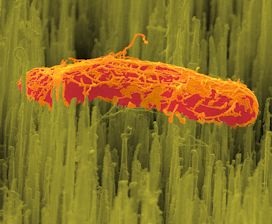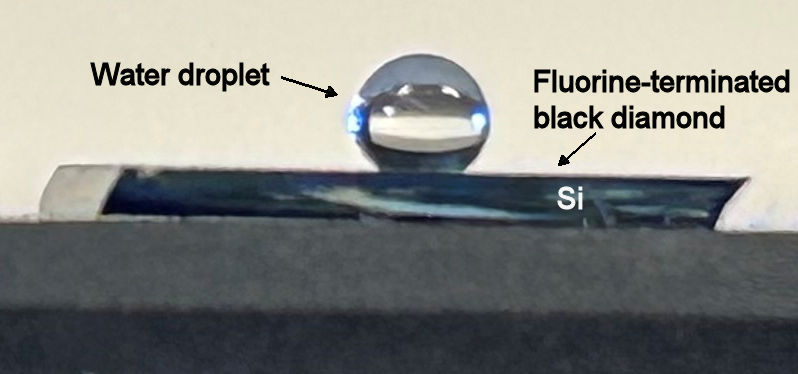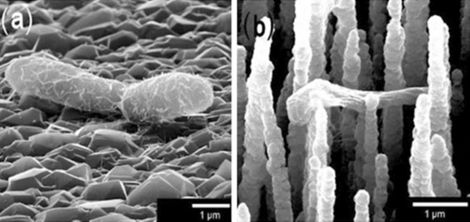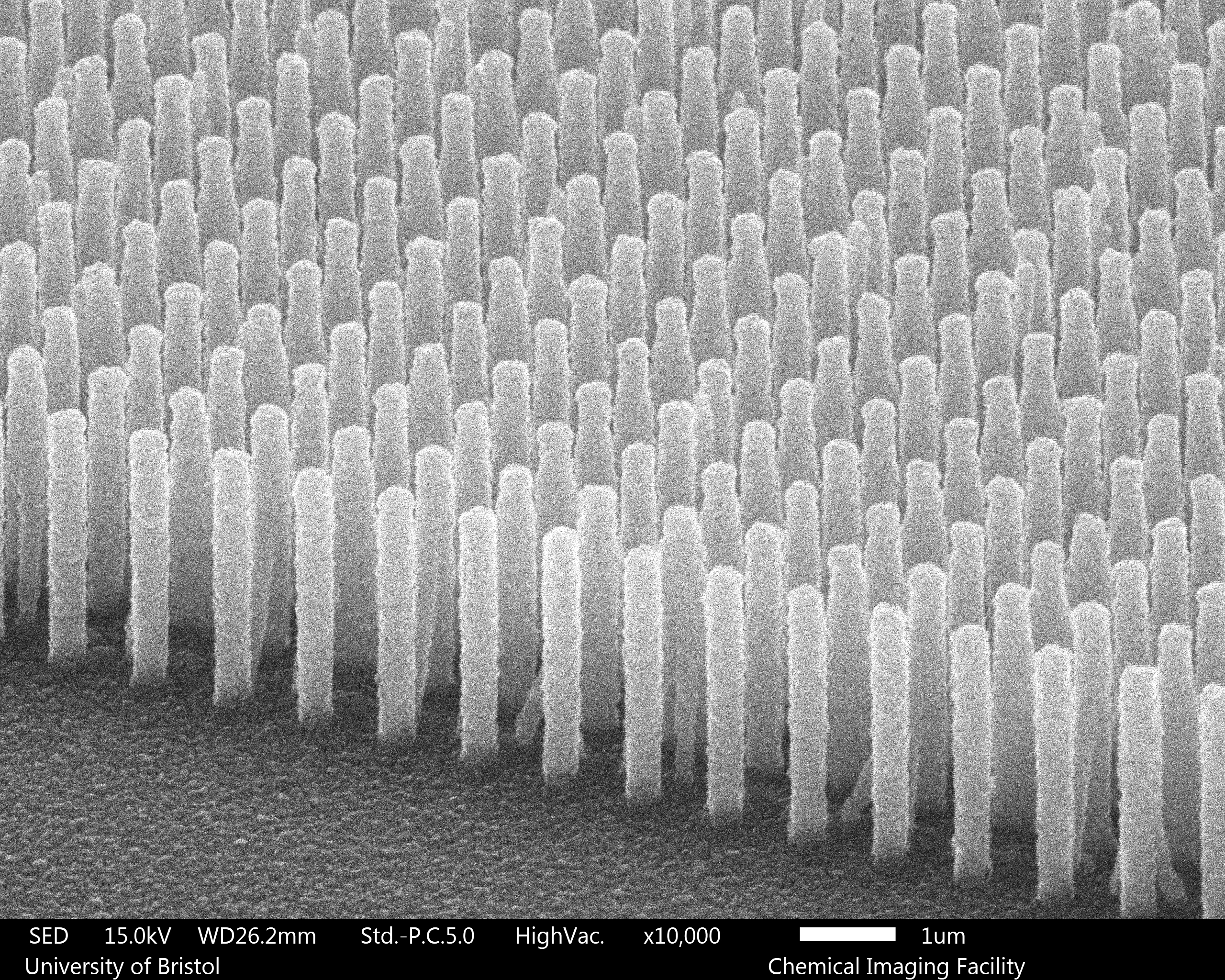 Black-Diamond Antibacterial surfaces
Black-Diamond Antibacterial surfaces
Taking inspiration from the nanostructured surfaces of cicada and dragonfly wings we recently showed that nanostructured diamond also generates a mechanical bactericidal effect, killing bacteria at high rates. The nanostructured diamond was produced by coating so-called ‘black silicon’ (bSi) with a conformal layer of CVD diamond. Black Si is a synthetic nanostructured material that contains high-aspect-ratio nanoprotrusions, such as nanospikes or nanoneedles, on its surface produced through plasma etching. The name ‘black silicon’ originates from its deep black colour, resulting from the absorption of >99% of the visible light falling onto its surface. Black Si has been reported to act as a bactericidal surface for both Gram-negative and Gram-positive bacteria, but the nanostructured Si surface is rather delicate and easily damaged or scratched, Coating these needles in a thin conformal layer of CVD diamond produced ‘black diamond’, which is more mechanically robust while still retaining its anti-microbial properties. |
 False-colour E-coli bacterium (red) on a spiky black silicon surface (green). The yellow colour is the extracellular material that eventually forms biofilm. |
![]()
Three types of black silicon. (a) Short needles, (b) medium needles, (c) long needles.
Changing the black diamond surface termination from as-grown hydrophobic H to hydrophilic O or to super-hydrophobic F, also affects the number of bacteria that initially stick to these surfaces, as well as the ultimate death rate.

Water-droplet test on F-terminated black-diamond surface.
The original fluorination of the diamond treatment was done by SF6 plasma exposure nearly 3 years before this test was done,
showing that the superhydrophobic character of the surface is maintained even after exposure to ambient conditions for many years!
We are collaborating with Romana Schirhagl’s group at Groningen University to study various types of black diamond and termination on biocidal efficiency, with the aim of developing a coating that can automatically kill all types of bacteria on contact, and prevent biofilm build-up – something that would be useful in the home as well as hospitals.

E. coli on (a) flat polycrystalline diamond,
and (b) black diamond, where it has ruptured and died.
 We are currently working on ways to replace black silicon, which is rather random and difficult to fabricate reproducibly, with bespoke patterned nanocolumns of Si. These are produced by nanolithography follwed by RIE etching of the Si. The optimum would be to make tall (h = 2 μm) closely spaced (p = 200 nm pitch), thin (w = 100 nm wide) columns in a dense grid structure, similar to that of bSi but more reproducible and controllable. All three parameters, h, p and w are controllable, allowing a range of different grid sizes to be tested. These nanocolumns are then coated with diamond (as shown in the right-hand pictures), and their antimicrobial performance vs Gram negative and positive bacteria is evaluated in a biolab.
We are currently working on ways to replace black silicon, which is rather random and difficult to fabricate reproducibly, with bespoke patterned nanocolumns of Si. These are produced by nanolithography follwed by RIE etching of the Si. The optimum would be to make tall (h = 2 μm) closely spaced (p = 200 nm pitch), thin (w = 100 nm wide) columns in a dense grid structure, similar to that of bSi but more reproducible and controllable. All three parameters, h, p and w are controllable, allowing a range of different grid sizes to be tested. These nanocolumns are then coated with diamond (as shown in the right-hand pictures), and their antimicrobial performance vs Gram negative and positive bacteria is evaluated in a biolab.
References:
- P.W. May, M. Clegg, T.A. Silva, H. Zanin, O. Fatibello-Filho, V. Celorrio, D.J. Fermin, C.C. Welch, G. Hazell, L. Fisher, A. Nobbs, B. Su, "Diamond-coated ‘black silicon’ as a promising material for high-surface-area electrochemical electrodes and antibacterial surfaces", J. Mater. Chem. B. 4 (2016) 5737-5746.
- G. Hazell, P.W. May, P. Taylor, A.H. Nobbs, C.C. Welch, B. Su, "Studies of Black Silicon and Black Diamond as materials for antibacterial surfaces", Biomaterials Science 6 (2018) 1424-1432.
- O. Dunseath, E.J.W. Smith, T. Al-Jeda, J.A. Smith, S. King, P.W. May, A.H. Nobbs, G. Hazell, C.C. Welch, B. Su, "Studies of Black Diamond as an antibacterial surface for Gram Negative bacteria: the interplay between chemical and mechanical bactericidal activity", Sci. Rep. 9 (2019) 8815.
- J. Jenkins, M.I. Ishak, M. Eales, A. Gholinia, S. Kulkarni, T.F. Keller, P.W. May, A.H. Nobbs, B. Su, "Resolving physical interactions between bacteria and nanotopographies with focused ion beam scanning electron microscopy", iScience 24 (2021) 102818. [doi: 10.1016/j.isci.2021.102818].
- N. Norouzi, W. Woudstra, E. Smith, G. Zulpukarova, K. Yao, V.G. Damle, R. Schirhagl, P.W. May, Tom Kamp, "Antimicrobial studies of black silicon and black diamond using Gram-positive bacteria", Adv. Engin. Mater. 25 (2023) 2301031. [doi: 10.1002/adem.202301031].
